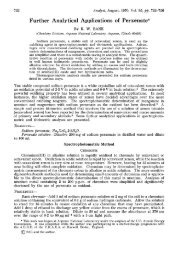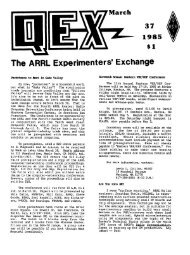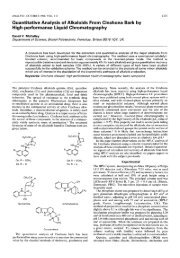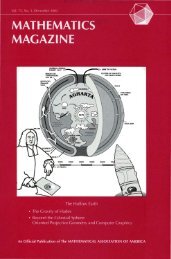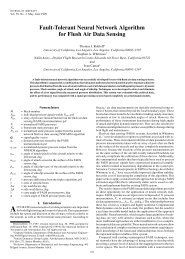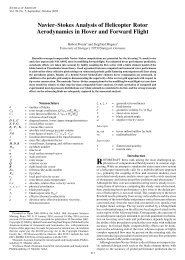pdf 6436KB Sep 25 2010 04
pdf 6436KB Sep 25 2010 04
pdf 6436KB Sep 25 2010 04
- TAGS
- 81.70.242.211
Create successful ePaper yourself
Turn your PDF publications into a flip-book with our unique Google optimized e-Paper software.
VHF-UHF Contesting!<br />
All-Time 6 meter VHF Contest QSO<br />
Records<br />
While not yet offi cial, W5PR is claiming<br />
more than 1700 QSOs in 278 grids in the<br />
ARRL June 2008 VHF QSO Party. Prior to<br />
this, Bob, K2DRH, had posted the all-time<br />
highest 6 meter contest total in any domestic<br />
VHF event. He did this in the 2006 CQ<br />
World Wide VHF Contest with a 6 meter<br />
line score of 1421 QSOs and 288 Grids.<br />
Bob’s total score that year was 700,701<br />
including an additional 260 QSOs and 73<br />
grids on 2 meters. Both 2006 and 2008<br />
were outstanding years for E S .<br />
To Drop or Not to Drop 6 Meters from<br />
the June VHF QSO Party<br />
According to a thread on the VHF Contest<br />
Refl ector, some contest ops believe<br />
the June VHF Party would be improved if<br />
it did not include 6 meters. Now, before<br />
you throw down this issue of NCJ in anger,<br />
there is a reason why some feel this way.<br />
In a June VHF QSO Party like this year’s<br />
with massive E s openings on 6 meters,<br />
most contestants — and particularly casual<br />
entrants — stay on 6. Often 2 meters<br />
and down are neglected. Operators who<br />
prefer UHF or microwave fi nd fewer stations<br />
to work. Thus — the reasoning goes<br />
— if the contest did not include 50 MHz,<br />
then contestants would have to operate<br />
on the higher bands where, presumably,<br />
there would be more activity.<br />
Personally I have some issues with this.<br />
Six meters is a VHF band and has every<br />
“right” to be included in a VHF-oriented<br />
operating event. If 6 meters were to be<br />
excluded from the permissible band lineup,<br />
June VHF contest participation — and log<br />
submissions — would plummet. Activity<br />
in areas away from the Northeast US<br />
and California would decrease. There is<br />
relatively little activity on the UHF or microwaves<br />
from the Rocky Mountain States<br />
or the Great Plains in comparison to what<br />
occurs on 50 MHz. While stations in those<br />
areas did work 2 meter E s , this was the<br />
rare exception.<br />
The June VHF QSO Party is the only<br />
ARRL VHF operating event with a reasonable<br />
probability of E s on 50 MHz. The<br />
<strong>Sep</strong>tember and January VHF contests are<br />
de facto 2 meter, UHF and microwave contests.<br />
E s on 6 meters sometimes occurs in<br />
<strong>Sep</strong>tember and January, but it’s rare. The<br />
multi-op stations operate all bands — 6<br />
meters through the microwaves. They even<br />
do so during big 6 meter E-skip openings.<br />
The current scoring system favors UHF<br />
and microwave contacts, however. To do<br />
well, top contestants must operate on as<br />
many bands as possible. Some years,<br />
34 November/December 2008 NCJ<br />
such as 2008, have seen good tropo and<br />
aurora conditions that favored the higher<br />
bands. So, I recommend leaving 6 meters<br />
in the June VHF QSO Party.<br />
DXpedition Lessons for VHF<br />
Contesters<br />
Several dedicated 6-meter-only DXpeditions<br />
took place in late June and early July.<br />
These included TO5E from St Barthelemy,<br />
CYØX from Sable Island and 5JØM from<br />
San Andres. TO5E made nearly 1800<br />
QSOs on 6 meters, while CYØX logged<br />
nearly 4000 contacts, possibly setting an<br />
all-time record for DXpedition QSOs on<br />
6 meters.<br />
These stations have some characteristics<br />
in common that VHF contesters may<br />
fi nd applicable. In addition to having good<br />
locations, they ran high power into large<br />
Yagi antennas. When operating, team<br />
members would call CQ consistently on a<br />
particular frequency, often using CW. The<br />
Jon K. Jones, NØJK<br />
operators stayed in the chair and kept at it,<br />
whether or not they had apparent propagation.<br />
By doing so they caught nearly every<br />
possible opening. They heard well, and<br />
modest little pistol stations were able to<br />
work them. CYØX heard my indoor dipole<br />
from EM28 on 6 meters July 8 (thanks,<br />
guys!). They do not give up.<br />
CYØX’s stay on Sable Island was extended<br />
due to fog that kept the charter<br />
plane from picking the team up. They continued<br />
to operate on 6 with 100 W into a 5<br />
element Yagi. By doing this, CYØX caught<br />
several big coast-to-coast E s openings<br />
across the US and gave many ops a new<br />
country on 6.<br />
The lessons? Build as good a station as<br />
you are able with the biggest and highest<br />
antenna you can put up. During the contest,<br />
call CQ often and stay in the chair.<br />
Listen carefully for weaker signals and<br />
don’t give up. Persistence is key!



